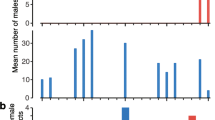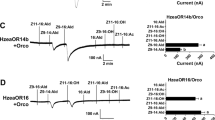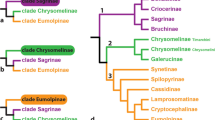Abstract
The presence of geranyl octanoate, previously found in pheromone gland extracts of Agriotes lineatus females, was also demonstrated in gland extracts of A. proximus females. Similar to A. lineatus, geranyl butanoate was present only in trace amounts in A. proximus female gland extracts. In air entrainment samples of female A. lineatus and A. proximus beetles, the relative ratio of geranyl butanoate and geranyl octanoate was higher than that in gland extracts. In addition, comparison of a segment of the mitochondrial cytochrome c oxidase subunit I gene of feral specimens of A. lineatus and A. proximus showed >99% similarity. Both pheromone profile and nucleotide sequence analysis delineate close relationship between the investigated taxa and postulate taxonomic revision. Further studies on sympatric populations of A. lineatus and A. proximus are underway to investigate and better understand possible processes of species diversification.



Similar content being viewed by others
References
Altschul SF, Madden TL, Schäffer AA, Zhang J, Zhang Z, Miller W, Lipman DJ (1997) Gapped BLAST and PSI-BLAST: a new generation of protein database search programs. Nucleic Acids Res 25:3389–3402. doi:10.1093/nar/25.17.3389
Baltensweiler VW, Priesner E (1988) A study of pheromone polymorphism in Zeiraphera diniana Gn. (Lep., Tortricidae). 3. Specificity of attraction to synthetic pheromone sources by different male response types from two host races. J Appl Entomol 106:217–231. doi:10.1111/j.1439-0418.1988.tb00587.x
Boland W, Ney P, Jaenickea L, Gassmann G (1984) A “closed-loop-stripping” technique as a versatile tool for metabolic studies of volatiles. In: Schreier P (ed) Analysis of volatiles. Walter de Gruyter, Berlin, pp 371–380
Borg-Karlson AK, Agren L, Dobson HB, Bergström BG (1988) Identification and electroantennographic activity of sex-specific geranyl esters in an abdominal gland of female Agriotes obscurus (L.) and A. lineatus (L.) (Coleoptera: Elateridae). Experientia 44:531–534. doi:10.1007/BF01958940
Furlan L, Curto G, Ferrari R, Boriani L, Bourlot G, Turchi A (2000) Wireworm species damaging crops in Po Valley. Informatore Fitopatologico 5:53–59
Furlan L, Garofalo N, Tóth M (2004) Biologia comparata di Agriotes sordidus Illiger nel Nord e Centro-Sud dę Italia. Informatore Fitopatologico 10:49–54
Hebert PDN, Cywinska A, Ball SL, deWaard JR (2003) Biological identifications through DNA barcodes. Proc R Soc B 270:313–321. doi:10.1098/rspb.2002.2218
Heinze J, Trindl A, Seifert B, Yamauchi K (2005) Evolution of male morphology in the ant genus Cardiocondyla. Mol Phylogenet Evol 37:278–288. doi:10.1016/j.ympev.2005.04.005
Hunt T, Bergsten J, Levkanicova Z, Papadopoulou A, John OS, Wild R, Hammond PM, Ahrens D, Balke M, Caterino MS, Gómez-Zurita J, Ribera I, Barraclough TG, Bocakova M, Bocak L, Vogler AP (2007) A comprehensive phylogeny of beetles reveals the evolutionary origins of a superradiation. Science 318:1913–1916. doi:10.1126/science.1146954
Kudryavtsev I, Siirde K, Lääts K, Ismailov V, Pristavko V (1993) Determination of distribution of harmful click beetle species (Coleoptera, Elateridae) by synthetic sex pheromones. J Chem Ecol 19:1607–1611. doi:10.1007/BF00982295
Laibner S (2000) Elateridae of the Czech and Slovak Republics. Kabourek, Zlin
Lohse GA (1979) 68. Familie: Elateridae. In: Freude H, Harde KW, Lohse GA (eds) Die Käfer Mitteleuropas. Band 6. Diversicornia. Goecke & Evers, Krefeld, pp 103–186
Merivee E, Erm A (1993) Studies on sex pheromone gland morphology and pheromone components, in female elaterid beetles Agriotes obscurus L. and Agriotes lineatus L. (Coleoptera, Elateridae). Eesti Teaduste Akadeemia Toimetised Bioloogia 42:108–117
Mertlik J, Platia G (2008) Catalogue of the family Cebrionidae, Elateridae, Lissomidae, Melasidae and Throscidae (Coleoptera) from Turkey. Elateridarium 2:1–40
Millar JG, Sims JJ (1998) Preparation, cleanup, and preliminary fractionation of extracts. In: Millar JG, Haynes KF (eds) Methods in chemical ecology I: Chemical methods. Kluwer Academic Publishers, Boston, pp 1–37
Roelofs WL, Du JW, Tang XH, Robbins PS, Eckenrode CJ (1985) Three European corn borer populations in New York based on sex pheromones and voltinism. J Chem Ecol 11:829–836. doi:10.1007/BF01012071
Scsegolev VN (1951) Mezőgazdasági rovartan. Akadémiai Kiadó, Budapest, p 695
Siirde K, Lääts K, Erm A, Kogerman A, Kudryavtsev I, Ismailov V, Pristavko V (1993) Structure-activity relationships of synthetic pheromone components in sex communication of click beetles (Coleoptera, Elateridae). J Chem Ecol 19:1597–1606. doi:10.1007/BF00982294
Simon C, Frati F, Beckenback A, Crespi B, Liu H, Flook P (1994) Evolution, weighting, and phylogenetic utility of mitochondrial gene sequences and a compilation of conserved PCR primers. Ann Entomol Soc Am 87:651–701. doi:0013-8746/94/0651-0701$02.00/0
Staudacher K, Pitterl P, Furlan L, Cate PC, Traugott M (2011) PCR-based species identification of Agriotes larvae. Bull Entomol Res. doi:10.1017/S0007485310000337
Subchev M, Toshova T, Furlan L, Tóth M (2005) Click beetles (Coleoptera: Elateridae) and their seasonal swarming as established by pheromone traps in different plant habitats in Bulgaria: 2. Maize. Acta Zool Bulg 57:321–332
Subchev M, Toshova T, Furlan L, Tóth M (2006) Click beetles (Coleoptera: Elateridae) and their seasonal swarming as established by pheromone traps in different plant habitats in Bulgaria: 3. Potato. Acta Zool Bulg 58:361–370
Tamura K, Dudley J, Nei M, Kumar S (2007) MEGA4: Molecular Evolutionary Genetics Analysis (MEGA) software version 4.0. Mol Biol Evol 24:1596–1599. doi:10.1093/molbev/msm092
Thompson JD, Higgins DG, Gibson TJ (1994) Clustal W: improving the sensitivity of progressive multiple sequence alignment through sequence weighting, position-specific gap penalties and weight matrix choice. Nucleic Acids Res 22:4673–4680
Tóth Z (1990) Family: Elateridae. In: Jermy T, Balázs K (eds) A növényvédelmi állattan kézikönyve 3/A. Akadémiai Kiadó, Budapest, pp 30–70
Tóth M, Furlan L (2005) Pheromone composition of European click beetle pests (Coleoptera, Elateridae): common components—selective lures. IOBC/WPRS Bull 28:133–142
Tóth M, Furlan L, Yatsynin VG, Ujváry I, Szarukán I, Imrei Z, Tolasch T, Francke W, Jossi W (2003) Identification of pheromones and optimization of bait composition for click beetle pests in Central and Western Europe (Coleoptera: Elateridae). Pest Manag Sci 59:417–425. doi:10.1002/ps.629
Tóth M, Furlan L, Xavier A, Vuts J, Toshova T, Subchev M, Szarukán I, Yatsynin V (2008) New sex attractant composition for the click beetle Agriotes proximus: similarity to the pheromone of A. lineatus. J Chem Ecol 34:107–111. doi:10.1007/s10886-007-9398-7
Vernon RS, Tóth M (2007) Evaluation of pheromones and a new trap for monitoring Agriotes lineatus and Agriotes obscurus in the Fraser Valley of British Columbia. J Chem Ecol 33:345–351. doi:10.1007/s10886-006-9217-6
Yatsynin VG, Oleschenko IN, Rubanova EV, Ismailov VY (1980) Identification of active components of the sex pheromones of click beetles Agriotes gurgistanus, A. litigiosus and A. lineatus. Khim Sel’sk Khoz Edition Moskva, Khimiya, pp 33–35
Yatsynin VG, Rubanova EV, Okhrimenko NV (1996a) Identification of female-produced sex pheromones and their geographical differences in pheromone gland extract composition from click beetles (Col., Elateridae). J Appl Entomol 120:463–466. doi:10.1111/j.1439-0418.1996.tb01636.x
Yatsynin VG, Karpenko NN, Orlov VN (1996b) Sex pheromone of the click beetle Agriotes sputator L. (Coleoptera: Elateridae). Khim Komm Zhivot, Edition Moskva, Nauka, pp 53–57
Acknowledgments
This work was partially supported by grant DO02-244/2008 of the Bulgarian National Scientific Fund and by OTKA grant K 81494 of HAS. Comments by anonymous referees and the editors greatly improved the relevance of the work presented.
Author information
Authors and Affiliations
Corresponding author
Rights and permissions
About this article
Cite this article
Vuts, J., Tolasch, T., Furlan, L. et al. Agriotes proximus and A. lineatus (Coleoptera: Elateridae): a comparative study on the pheromone composition and cytochrome c oxidase subunit I gene sequence. Chemoecology 22, 23–28 (2012). https://doi.org/10.1007/s00049-011-0091-5
Received:
Accepted:
Published:
Issue Date:
DOI: https://doi.org/10.1007/s00049-011-0091-5




